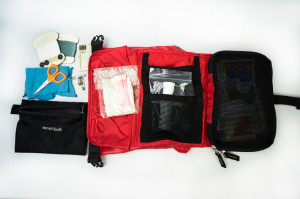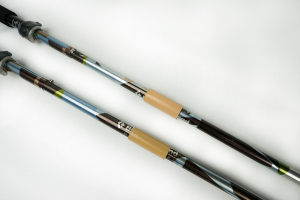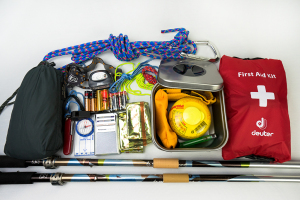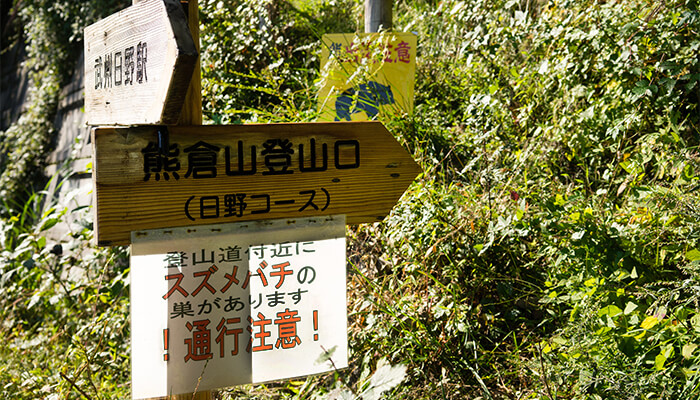
10 essential gear you should never forget to enjoy solo hiking
table of contents
Solo hikes that spread the joy of mountains are hot
The mountaineering boom that has been going on for several years has gradually become more and more common, and I get the impression that there are a lot of people who enjoy climbing alone, such as solo hikers. I feel like it has long been the term "single trip" with the image of being "single trip", but recently I've seen a few books in bookstores that talk positively with new names, such as "solo hiking, solo hiking" and "hiking alone." I, as a working adult, started to go to the mountains on my own, because I wanted to take photos at my favorite pace, and it became difficult to settle time with my friends, and before I knew it, I had more opportunities to go to the mountains by myself, and before I knew it, I had no choice but to get out of the "solo hike swamp." I will talk about the fun of solo hiking on another occasion, but only after this happened, I often thought about rethinking the way you think about it and the equipment you carry. So this time I would like to introduce some of the essential equipment I felt, which is something that you can only miss out on solo hiking.
The mindset of solo hiking is something you should be careful about when you're alone
The real joy of solo hiking is that it is "freedom." In order to enjoy this, solo hikers will likely be keen to take quiet routes where there are fewer people as possible. This is the story of when I went to Mt. Kumakura in Chichibu. A sign (title photo) peeked at the trailhead. I confessed to my shame and realized that when I was stabbed by a wasp I had no idea what to do specifically. This was so bad I hurried back to the point where I could connect to the internet and checked first aid. Of course, I didn't have any outdoor poison removers that are effective as first aid, so I decided to go home when I came over even more, and I remember passing through this mountain hike with a lot of trembling excitement. By the way, in the end, no wasps appeared, and the mountain itself was wonderful and had a great forest, which was great.
There are many other similarities that can be seen when you remember, but when you enter the mountains alone, you realize how dangerous the daily life you live in is. In other words, when enjoying solo hiking, the only thing you should never forget is that no one will guarantee safety in the outdoors. No matter how hard you are, it's best to assume that if you accidentally get into an accident while hiking, no one will understand you. It's easy to go to the mountains by yourself, but you should keep in mind that in reality you need the ability to deal with everything that happens on your own, in other words, you need the ability to get through (and even turn back) any situation. Of course, not everyone has that perfect ability, so what I keep every day is to give up if I feel even a little risky. Even if it's irreplaceable for me, no matter how far I go, it's just mountain climbing. I think that's enough.
"Preparation in case" is the essential gear for solo hikers
So, the essential equipment I would like to share with beginner solo hiking is of course the emergency gear. When climbing with multiple people, they often carry it as joint equipment, so I tend to leave it at home, but in essence, when climbing, you should be prepared to deal with everything yourself, and especially when hiking, you should have it all without exception. That being said, too much weight only increases the risk and increases the risk, so this balance is a concern every time, but below, I would like to introduce 10 emergency equipment that I bring at least even on light mountain climbing such as day trips.
1. First Aid Kit (Emergency Medical Products)
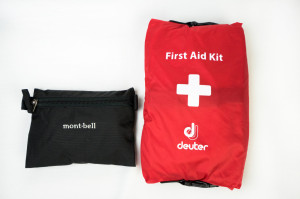
Put the First Aid kit in a waterproof bag as it will be useless if it gets wet. Deuter's waterproof bags are recommended because of their size and buckle specifications. Put the sewing set on the left together here.
This is a collection of emergency medical supplies, including preparations for injuries and illnesses that are expected in the mountains. There are almost always a list of mountain equipment lists, so I don't think there's any need to mention the necessity here, but the worst thing is to buy a set that is sold at a mountain equipment store and bring it to it as is. It's pointless to have nothing to think about when you have the opportunity to use it or don't know how to use it, so you should try to bring just the bare minimum of what you need to use and use.
In my case, when I go for the minimum day trip, I will avoid any unnecessary things, especially first aid measures for injuries and sudden pain. For your reference, here is my list of emergency medical products that I have at this point calm (although I don't think this is perfect at all).
- Bandage (several sizes)
- Cotton swab
- Sterilized gauze, tissue
- Disinfectant
- Painful medication
- Gastrointestinal medication
- Anti-diarrheal medication
- Cold medicine
- Poison remover
- taping
- Antihistamine ointment (insect bites)
- Scissors
- Safety Pin
I plan to substitute bandanas, towels and any other fabrics for triangular bandages. If you want to reduce the weight even at 0.1g, you can choose more about cold medicines and gastrointestinal medicines, while consulting with the season and physical condition.
2. Repair tools
What if you walk through the mountains and the soles of your shoes start to peel off? This repair tool is a relief when you are in an unexpected situation, but it is difficult to be able to be fully prepared with this specific situation. The key point is that it is not a tool for perfect repairs, but as long as there is something that can provide first aid in case of damage. In my case, it's a three-piece set of duct tape, wire, and thin pull (a set of knives and pliers). If your shoes are broken, you can wrap them with duct tape or wire, or use duct tape around the holes in your clothing, or use thin strips if the shoelaces are broken or you need to tie them together, and you can temporarily deceive most damages by simply accepting that you can just go down the mountain. Of course, it goes without saying that if this is a place to stay or winter equipment, it is necessary to make more severe assumptions such as crampons and tents.
3. Headlamp (including spare battery and light bulb)
Even if you plan to descend the mountain while it is bright, if it is late, the road will be pitch black. If that happens, the mountain is incapable of taking action all at once, and it's out of nowhere. Also, if you have to bivouac and spend the night, it is entirely possible that you can make a difference between life and death depending on whether there is light.
4. Firearms (stoves, cartridges, lighters)
No matter how you go to the mountains, I always bring a stove, gas cartridge, a lighter, and a cooker that can be put on fire. Even if a bivouac experiences a pain, you can just drink warm things and stay strong both physically and mentally.
5. Emergency food
In my case, I always bring a lot of lunch with me, so I bring a box of calorie mates with me, which I would expect to last just a day if I really can't do anything about emergency food.
6. Dust tape
It's duct tape again. Of course, the material is fabric. As I introduced it as a repair tool I introduced earlier, duct tape can be used in a variety of other useful ways. For example, use when you want to hold the camera a little. Or as a bandage in the unlikely event. Use as a lid after opening a bag of ingredients or other items. And the most surprising way I was to use it as a fire starter for bonfires. There is no need to carry a lot, so wrap the required amount around a cylindrical tool such as a water bottle or pole and carry it with you.
7. Portable radio (including spare battery)
The sudden deterioration in weather, an unexpected bivouac may be locked up for a few days... For example, radio is still active as an information gathering tool. Nowadays, there are more options for collecting information, such as mobile phones and OneSeg, so there may be no need to be particular about radio, but radios are still easier to connect than mobile phones, and the battery is also much better, so you can rest assured.
8. Water
Of course, everyone has water for their activities, but in this case, water means water that is always given some room for cleaning in the unlikely event. I'm always having trouble worrying about this, so I throw a 500ml plastic bottle or water bottle inside separately from my active drinks.
9. Whistle
The cases where the flute is usually used in the mountains are various, such as signaling members from far away, avoiding bears, or warning them of dangers such as falling rocks. In short, it is used when you want to send a big signal of urgentness as far as possible, but with solo hiking, the need for this is even greater. If you are slipping or losing your way on a solo hike and you are out of the road, if you can't send us a signal, no one will notice.
10. Bivouac Tools
Of course, I'm not saying you should bring your tent on a day trip. However, if you have to spend the night in the mountains, it is important to be able to somehow prevent the rain and wind and have an environment where you can sleep. The typical gear made for this purpose is Zert, but that's not the only answer. A survival sheet made of lightweight, heat-retaining material that will completely shave your body, a vivie sack is an infinitely close to a tent, or a tarp in a season that is sufficient to prevent wind and rain. In my case, I don't particularly recommend it, but instead of using more cold weather gear, I only bring a large sleeping bag cover (waterproof and breathable material) with me as my bivouac tools. If you're going to sleep, if you're cold, wear all the clothes, gloves, and neck warmers inside the sleeping bag cover, and wrap your body around with an emergency seat. Naturally, there is no comfort in the event of an emergency, so I will assume it is for emergency purposes only. If I know that I might use it during the day, I will give up and retreat every time.
summary
Above, I've introduced my thoughts and examples of gear that I don't want to think about too much about when hiking solos, but I definitely shouldn't forget. As an aside, it is pointless to have tools, and it goes without saying that it is only meaningless to learn how to use them using a variety of means, such as books and lessons. And while I write about these incredible things, I also often feel that I can stay this safe. It goes without saying that Mount Ontake the other day is the outdoors where it's not surprising no matter how much you prepare, and who and what happens, and solo hiking is where you can experience the most essential part of this. This danger and fulfillment are two sides of the same coin, and I once again feel that what makes Solo Hike is all about. Not everyone can do it from the beginning, just gain knowledge and experience at your own pace. The content I wrote here is just one step, but I hope this will be useful not only for beginners in solo hiking, but also for those who are thinking of trying solo hiking someday.


